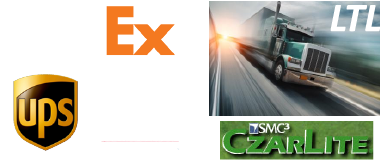Part # 10110 - HMU version 200 electronic PLD file creation and upload (included with UPS)
This option prepares an electronic version of the manifest to be transmitted to UPS. Includes Host Computer Interface Software, prepared UPS version 200 PLD electronic manifest file ready for transport, a user routine that will facilitate moving the prepared file to a final transport location.
* HMU Version 200 replaces all previous OnLine upload methods.
* Customer is responsible for transfer of the PLD file to UPS via SCI NetSuite or its Web facility. |
|
Part # 10089 - Ship Manager Server Interface. Transmits shipments directly to FedEx (included with FedEx)
This gives you the ability to communicate bi-directionally with a FedEx Ship Manager Server (SMS). The software allows PSS to transmit all of your FedEx domestic and international shipments to FedEx and retrieve tracking numbers and other routing information from the server. An approved shipping label is generated, thus eliminating the need to print or type Airbills or Waybills. Included is a user-modifiable program to transmit certain reference data (PO number, sales order number, etc.) to the FedEx SMS. PSS maintains a complete set of list and discounted FedEx shipping rates which are used for customer billing purposes and to audit your FedEx invoices. The end-of-day process generates an internal shipping manifest and signals the server to upload all of the day's shipping information to FedEx without the need for any additional software.
* Customer is responsible for arranging FedEx SMS software installations and upgrades with FedEx and coordinating same with SCI.
* FedEx requires submission of sample labels from the user's printer. SCI will assist with this process on a T&M basis.
* Communication with the FedEx server requires the use of SCI NetSuite client software or the ability of your system to execute socket reads and writes.
* PSS currently supports SMS versions 10.0x through 12.0x. |
|
Part # 10138 - USPS Electronic Verification System - eVSŪ (included with USPS)
This replaces the paper Manifests and Postage Statements that are currently used as billing documents and to report each day's shipments to the USPS. Instead, an electronic eVS file is generated as part of your normal end-of-day close and then sent via secure ftp to a USPS designated address. Master mailer ID numbers are assigned to eVS users and individual mailer ID numbers are assigned for to each warehouse. As a result, PSS provides eVS users with the option of closing USPS shipments individually and creating separate upload files for each warehouse or running a consolidated close for all USPS shipments at the end of the day. The daily reports users are accustomed to printing are still available, but they are for internal use only and there is no requirement to submit them to local Post Offices. By adopting the eVS system, shippers no longer have to be concerned with keeping USPS Manifests and Postage Statements up to date as well as having to deal with one Post Office refusing to accept documents that another Post Office has already approved. The PSS USPS eVS option supports shipments via Express Mail, First Class Packages, Priority Mail, Parcel Select, Media Mail and Library Mail, and includes special eVS shipping labels for all printers supported by PSS.
* USPS personnel are available to guide users through the application and certification processes, postage payment arrangements and assist wherever necessary.
* A certification process is required which entails the submission of an eVS test file with 100 shipments and related shipping labels. Included with the eVS option are 100 test cases and a program to generate the necessary certification file and labels. Assistance, if necessary, will be provided by PSS on a T&M basis. |
|
Part # 10009 - Hazardous Materials library and 8-part package labels (included with UPS and FedEx)
In order to identify packages containing hazardous materials, this option allows you to create and maintain a library of hazardous codes and then assign the codes to packages containing these items. An approved 8-part hazardous label defining package contents is printed on a laser printer, and a user-modifiable program is provided to print custom labels when needed. An approved Hazardous Materials report is printed for your driver when packages are picked up at the end of the day.
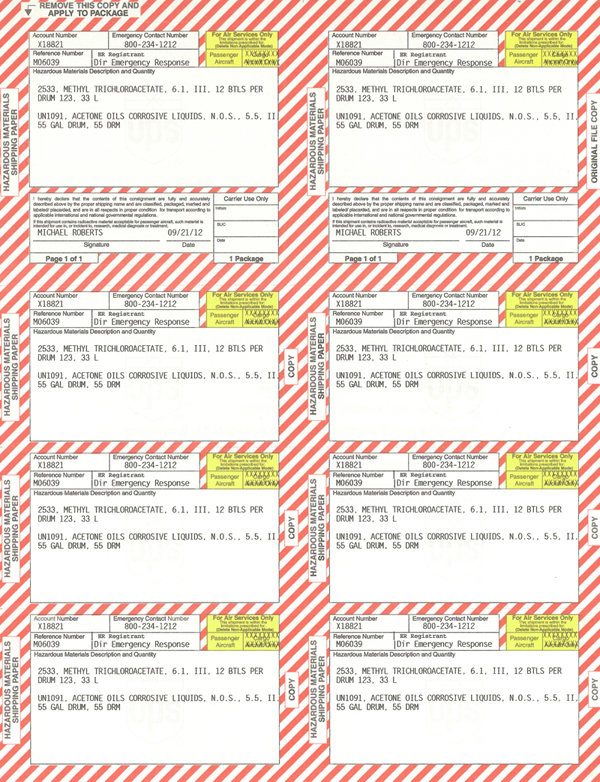
* Licensee will assume all responsibility and SCI will assume no responsibility for using this option.
|
|
Part # 10113 - Hazardous Materials library and multi-part IATA form (included with LTL / local carriers)
In order to identify packages containing hazardous materials, this allows you to create and maintain a library of hazardous codes and then assign the codes to packages containing these items. An approved multi-part Hazardous Materials IATA form is printed on your dot-matrix printer, and a user-modifiable program is provided to print a custom hazardous label when needed.
* Licensee will assume all responsibility and SCI will assume no responsibility for using this option. |
|
Part # 10014 - Level II Interface. This facilitates the connection between PSS and your database
PSS uses this interface, which includes a user-modifiable program, to allow direct access to and from your data files. Shipping information such as the consignee’s name, address, and method of shipment can be retrieved from your production system (ex. customer or order files). The same interface is used to allow you to update your production system with the PSS shipping information (ex. update your invoice with the freight charge and date shipped). There are various times throughout the processing of shipments that PSS will turn control over to the interface program. These “hooks” allow you to customize and automate the way PSS interacts with your users.
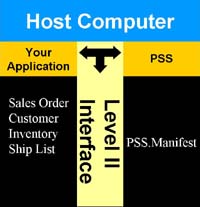
* A skeleton program is provided and must be customized for your application software before it can be used. |
|
Part # 10001 - Bar Code Module. Scan a bar code rather than entering the order # for a shipment
For increased speed and accuracy, PSS can interpret one scanned bar code from your document (ex. picking ticket, order form) to obtain information that would otherwise have to be entered in four different places (company #, invoice / order / pick-slip #, shipment #, and box #). This provides PSS with the information it needs to identify the shipment and proceed directly into the box processing stage. The included user-modifiable program reduces the likelihood that you will need to make any changes to your bar code. |
|
Part # 10069 - Alternate Party Billing. Allows Collect, Consignee and 3rd Party billing
This feature allows you to process collect, consignee (UPS and FedEx) and third party billed shipments. All necessary information (customer account numbers, phone numbers, etc.) are captured from your database via the Level II Interface. For UPS and FedEx, alternate party billed shipments are included included in the files transmitted to your carriers at the end of the day. For LTL shipments, alternate party information can be printed on your bills of lading if you so choose. |
|
Part # 10086 - Delivery Confirmation. Allows shipment tracking on the USPS web site (included with USPS)
Delivery Confirmation is included for all of your domestic USPS shipments. You will be able to track package progress and delivery (location, time, date, etc.) on the USPS web site. PSS will assign a USPS tracking number and print an approved bar-coded shipping label for each package. |
|
Part # 10004 - Non-Rated Carriers. Create local carriers and enter freight charges. (included with LTL / local)
This gives you the ability to create an unlimited number of non-rated local carriers. Freight charges for a given shipment can be entered in the PSS Rating Station and then updated to your database. |
|
Part # 10019 - Multi-part Bill of Lading. Use with multi-part standard forms (included with LTL / local carriers)
You can have PSS print your bill-of-lading forms instead of having them typed manually. The user modifiable print program assumes that there is one NMFC code per pallet, is set to print on a standard Rapid Forms bill-of-lading, and can easily be modified to print on your forms. The print program will also create a consolidated Bill of Lading if the Box Consolidation Option is licensed.
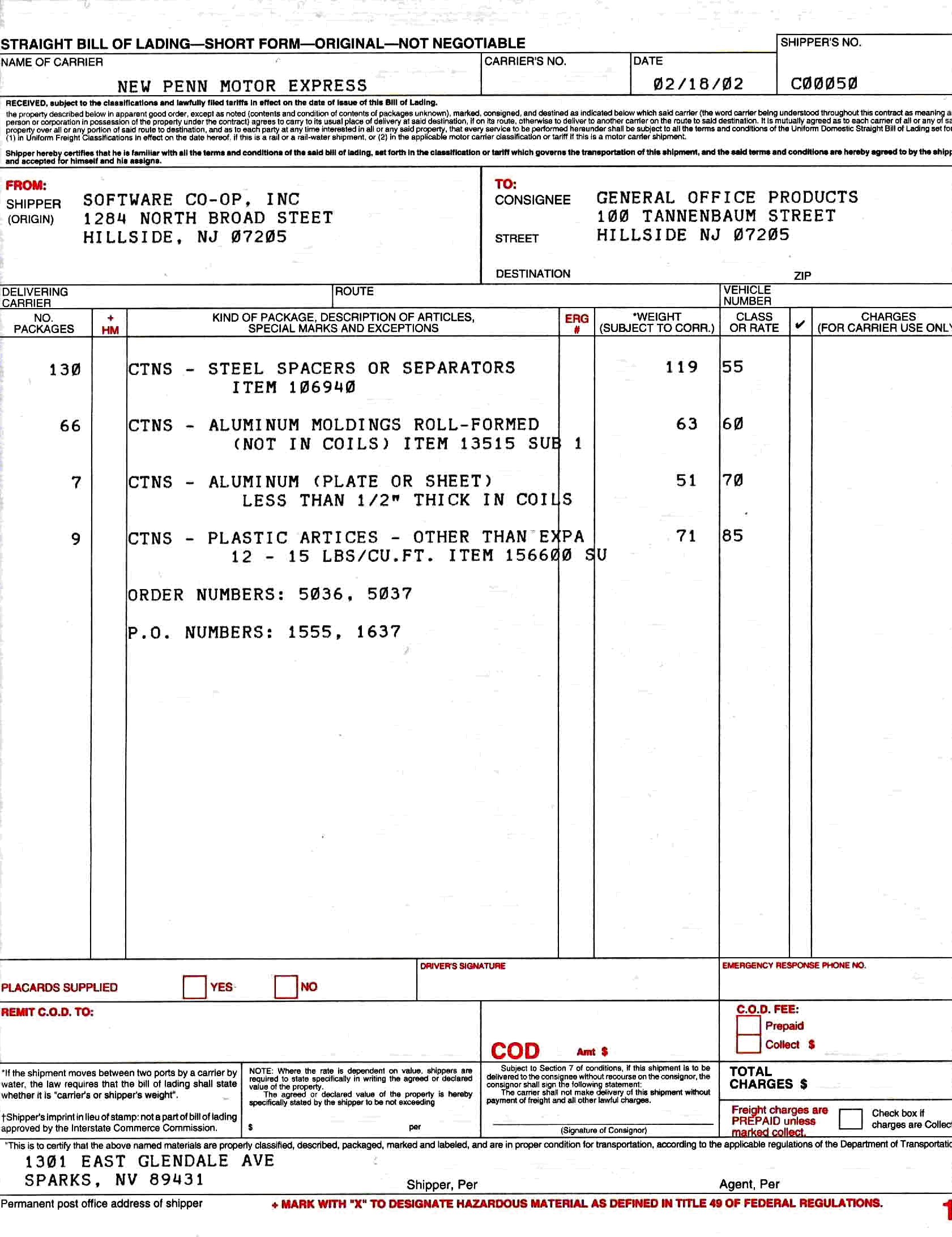
|
|
Part # 10117 - Bill of Lading form - PDF (included with LTL / local carriers)
This will create Bill of Lading in pdf format. It will also create a consolidated Bill of Lading if the Box Consolidation Option is licensed. The program will print a dynamic, personalized company banner which can be used simply as a logo or as a tool to introduce new products to your customers. The print program is user modifiable, and the resulting electronic document may be printed, archived, or included as an attachment when using our advanced email option.
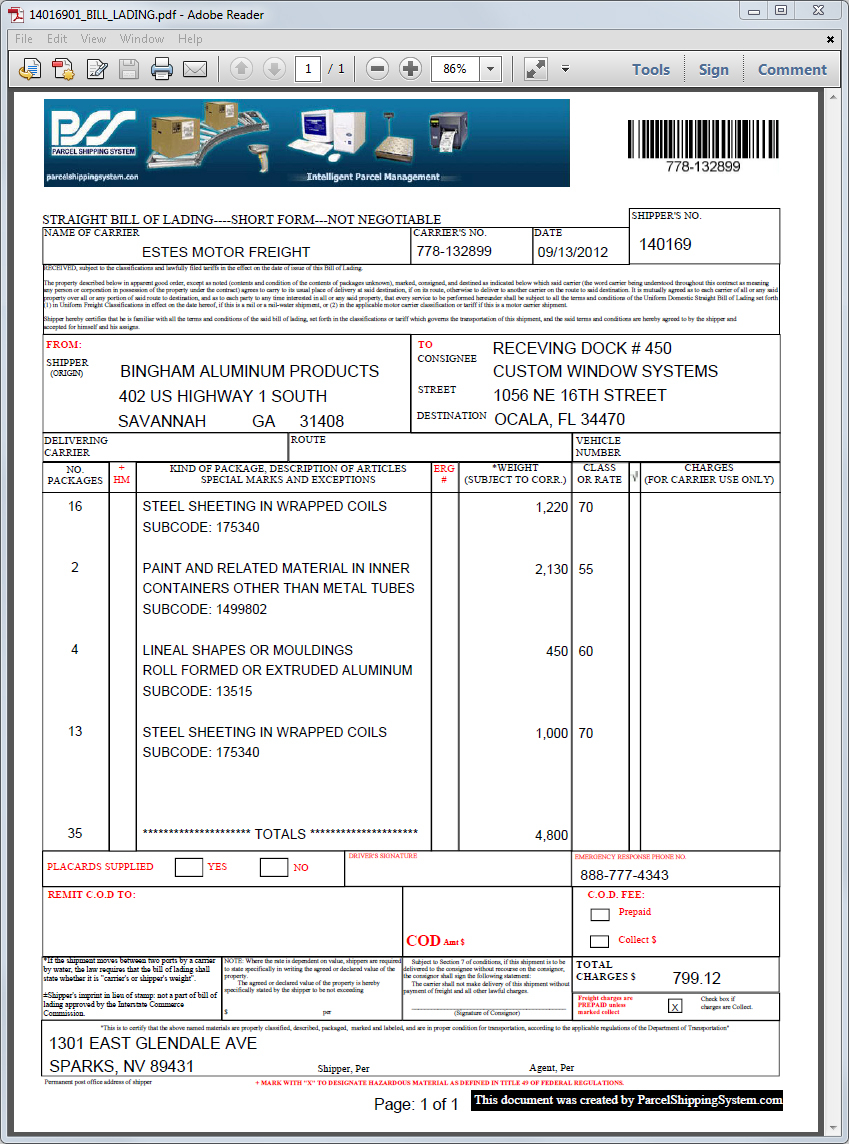
Notes that apply to all forms:
* Samples of all package forms are available on our web site.
* Level II interface customization is required and will be done on a T&M basis.
* Design, Installation, training, etc. will be done on a T&M basis.
* All forms can be customized on a T&M basis. |
|
Part # 10128 - Bill of Lading form - HP Laser (included with LTL / local carriers)
This will print a Bill of Lading on any HP or compatible laser printer. The format is the same as standard Rapid Forms bills of lading, thus eliminating the need for pre-printed forms. The program that generates the Bill of Lading is user modifiable, so the form can be customized to your needs.
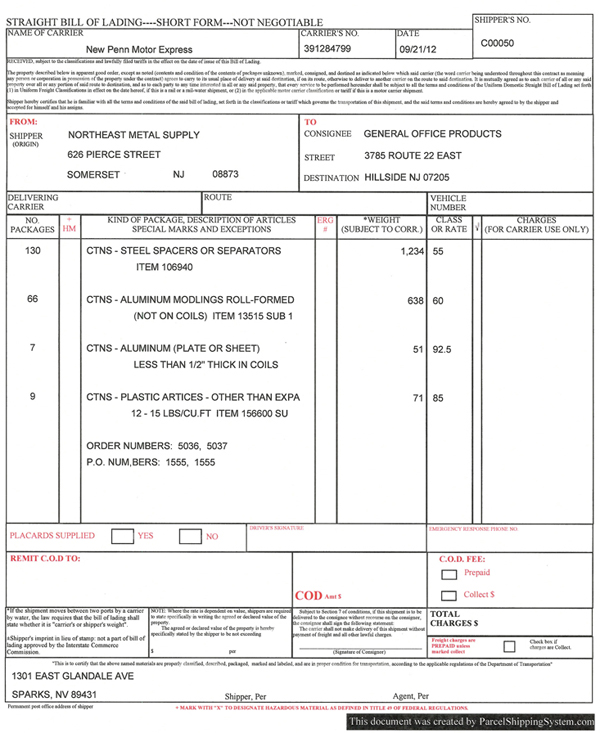
|
|
Part # 10122 - LTL Carrier Rate Converter. Convert LTL rates into PSS format (included with LTL / local carriers)
This allows you to convert into PSS format LTL carrier freight rates for shipments to any location in the U.S. and Canada. All that is needed to convert a carrier's freight rates are comma-delimited (.csv) rate spreadsheets in a simple format defined in the PSS Documentation. One spreadsheet is needed for each ship from location and rate class, and the spreadsheets can either be generated by your carriers' rating software or supplied by your carriers. In addition, this feature program can also be used to convert LTL carrier time-in-transit files when supplied by your carriers in a format defined in the PSS Documentation. |
|
Part # 10012 - Handling Charge. Add a user-defined handling fee per box or shipment
This feature gives you the ability to automatically add a handling charge to your shipping charges. The handling charge can be set up by parcel or by order and can be overridden by the operator if needed (and if you allow it). The included user-modifiable program enables you to make even more handling charge decisions automatically when the shipment is actually being processed. For example, you can base the handling charge on the customer or order total. |
|
Part # 10077 - Ship to Database. Create a database of non-customer names, addresses and ship via
This provides for the entry and maintenance of a stand-alone ship-to database that is integrated with the PSS rating & packing screens. When shipping a parcel that does not have a customer order associated with it (manual entry), this feature will save time and eliminate errors. By using “S” as an order number, PSS will bring the user into the ship-to database program. The ship-to can be cross-referenced by entering part of the name or filed as a new ship-to for future re-use. |
|
Part # 10005 - Picker Identification. Create codes for pickers and assign them to each box
You can monitor the employees involved with the shipping process by assigning them identifying codes. PSS will then prompt for the Picker Code to define the employee who picked the goods for a particular package or shipment. |
|
Part # 10006 - Packer Identification. Create codes for packers and assign them to each box
You can monitor the employees involved with the shipping process by assigning them identifying codes. PSS will then prompt for the Packer Code to define the employee who packed the goods for a particular package or shipment. |
|
Part # 10007 - Shipper Identification. Create codes for shippers and assign them to each box
You can monitor the employees involved with the shipping process by assigning them identifying codes. PSS will then prompt for the Shipper Code to define the employee who shipped the goods for a particular package or shipment. |
|
Part # 10079 - Zip Code Verification. Insure correct zip codes and that cities and states match
This software will verify that the zip code used in a shipment is valid and that it matches the city and state entered. If PSS senses a mismatch or invalid zip code, the user will be warned and allowed to easily correct the data. Included with this option is a data base which can be used by your other software applications and which contains the cities, preferred city (if more then one) and state for more then 42,000 zip codes in the continental US, Alaska, Hawaii and Puerto Rico.
* Must subscribe to the ZIP code maintenance service. |
|
Part # 10041 - External Rating Screen Access. Run the PSS shipping station from a user application
This allows the PSS Shipment Rating Station screen to be called by any user-written application. For example, this feature can be integrated with your packing process so that package rating and labeling can immediately follow it or it can be used by customer service to allow operators to check the status of a given order. This relieves the user of the necessity of writing a shipping inquiry screen and prevents operators from having to log off and onto PSS to check the shipping data. Included with this are the parameters for calling a subroutine that will call the PSS Rating Screen and then return control to the calling program. |
|
Part # 10043 - User Rating Routine. Calculate shipping charges from a user application
This provides you with the ability to calculate the complete shipping charges for a particular shipment from any user-written application. For example, you can use this routine with your order entry process to estimate freight charges for quoting customers. Insurance, COD’s, and any other accessorial services can also be included in the rating process. You simply call the Rating Routine by using the included parameters and the rating results are returned for you to use or display. There is also a rate quoting screen provided that allows you to quote freight charges without having to implement any subroutine calling.
* No Rating Station License Required. |
|
Part # 10131 - Shipment Rating Optimization. Determine if excess shipping costs are being incurred
This feature advises users when shipments via one of the UPS express services would arrive on the same day or before if shipped via Ground. In doing so, this provides the opportunity for substantial cost savings if a significant number of your shipments are made this way. When PSS detects that shipping via ground would be advantageous, the shipper is so advised and can easily change the carrier service before the shipment is updated. Without easy access to carrier time-in-transit information, order entry departments often select next or second day express service when shipping via ground would arrive on the same day or before. Examples of this are shipments from New York to Chicago, where ground gets there in the same amount of time as express second day service and New York to Philadelphia, where ground gets there in one day. In each case, choosing ground provides a minimum savings of 50% of the express freight cost. And because the program retrieves the latest time-in-transit information from the carrier's web site, the information used by PSS is always up to date.
* Requires Windows 7 and SCI NetSuite.net. |
|
Part # 10010 - Ship With Order Goods. Ship components of multiple orders in the same package
This software, also known as SWOG, allows users to link together shipments for different orders to the same customer on a given day. When shipments for different orders are packed in the same boxes, they are linked by both the order and carrier tracking numbers, and when either one is entered in the Rating Station a display will indicate what was shipped together. Billable freight charges can be allocated to different orders based on value or weight (if known), evenly based on the number of packages or any other business rules you choose to apply.
* Requires modifications to the Level II Interface program to verify that all shipments are to the same customer and address and to write tracking numbers, freight charges and other information back to the linked orders. |
|
Part # 10139 - Rate Shopping. Compare what other carriers would charge for the same shipment
This feature allows you to open a window while you are rating a shipment that will display both published and discounted rates for every carrier and service. The display groups all similar services together, highlights the least expensive and most profitable methods of shipment, and allows you to change the carrier at that time. |
|
Part # 10035 - Least Cost Carrier. Automatically choose which carrier costs you the least for each shipment
By setting parameters within PSS, you can have the Rating Station automatically select the least costly shipping method from amongst a group of services pre-defined by you. PSS can constantly update the least cost carrier as boxes are added, or the user can have PSS do the comparison on demand. This feature can easily be enabled and disabled programmatically via the Level II Interface. |
|
Part # 10002 - Generic Label Print. Print any kind of non-standard label
This program is used to print thermal shipping labels to be applied to packages where standard labels (UPS, FedEx and USPS) are not generated by PSS. It can also be used to generate custom labels that you want to apply to any or all packages. Examples of this are SSCN, special customer and carton contents labels. The generic label programs are user-modifiable and are provided for each label printer supported by PSS. |
|
